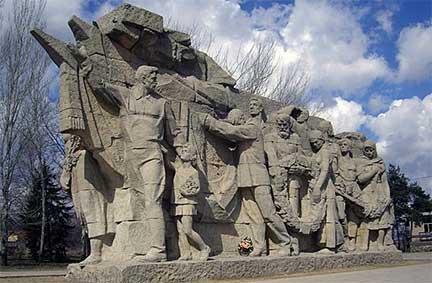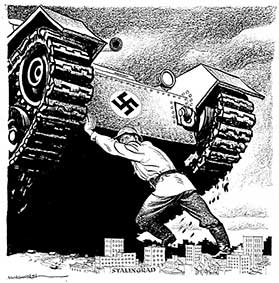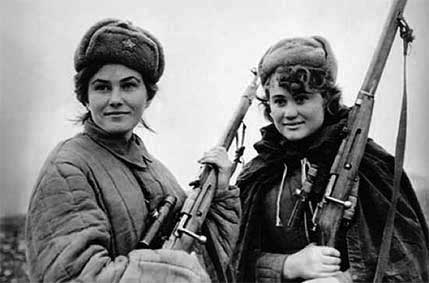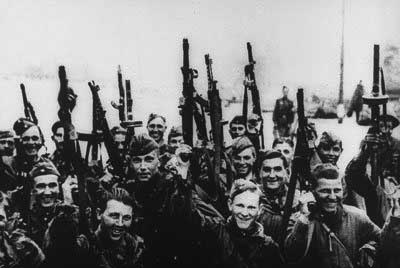Beginning of the Battle of Stalingrad A Crucial Turning Point in History |
||||
- George Allen - The turning point of the Second World War was the historic Soviet victory at the Battle of Stalingrad, which ended on February 2, 1943. The Germans treacherously invaded the Soviet Union on June 22, 1941. The Soviet Union faced 257 enemy divisions of 10,000-15,000 troops each, of which 207 were German, the largest army ever assembled in one place. By October 1942, the Nazi armies stood barely 120 km from Moscow, had broken into Stalingrad, and had entered the foothills of the Caucasus, trying to capture the valuable oilfields. But even in those dire days, the Soviet army and people, led by Joseph Stalin, found the strength to check the enemy and deal an answering blow. Soon they turned the tide. The Soviet troops eventually went over to the offensive and inflicted new, powerful blows on the Germans, first at Stalingrad, then at Kursk.
As the invaders were massing over one million soldiers and thousands of tanks, artillery pieces and planes on the Russian steppe west of Stalingrad, Stalin, the leader of the socialist Motherland, vowed that this was as far east as the criminals would go. "Not one step back!" became the battle cry of Stalingrad. The prelude to the Battle of Stalingrad began on July 27, 1942. The advancing German Fourth Panzer Army crossed the Don River north of Stalingrad and attacked eastward, cutting the Stalingrad-Salsk railway. Stalingrad sat in the big bend of the Volga river and the Germans wanted to direct their main attack towards the Volga River, trying to outflank the Soviet 64th Army and the whole Stalingrad front. The Germans had planned a two-pronged ground attack on Stalingrad, with the German Sixth Army advancing from the north and the Fourth Panzer Army coming up from the south.
After a month of very hard fighting against the stalwart Soviet defences, the German Sixth Army finally managed to cross the Don on August 23, reaching Stalingrad's northern suburbs later that day. The Hungarian, Italian, Croatian, and Romanian armies allied with the Germans were about 60 kilometres from Stalingrad, which was also within reach of Germany's air bases on occupied Soviet territory. Consequently, aircraft of Luftflotte 4, one of the primary divisions of the German Luftwaffe, were able to attack the city with bombers, dive bombers, and fighter planes, both night and day, vainly attempting to terrorize the city into surrendering. Meanwhile, the German 14th Panzer Corps opened a narrow breach between the German Sixth Army's main body and the northern Stalingrad suburbs at the Volga River, while in the south, heavy Soviet resistance stopped the Fourth Panzer Army from making any headway. On August 29, the Fourth Panzer Army finally broke through into the rear areas of both the 62nd and 64th Soviet Armies. The Germans attempted to cut off the 62nd Army, but a strong Soviet counterattack enabled Soviet forces to fall back towards Stalingrad. The German Sixth Army resumed its offensive on September 2, linking up with the Fourth Panzer Army the following day. The nearer the Germans got to Stalingrad, the more intense the fighting became and the Germans suffered huge losses. On September 12, the Germans entered Stalingrad itself and fighting within the city began the next day. In the forefront of the organized resistance were the units of the Red Army and Workers' Militia. The Workers' Militia fortified every factory and workplace so that even after being bombed, any attempt of the invading force to occupy the facility would be repulsed. Students and community members young and old were organized and armed to fight to defend their city and the rights of all. The Urban Committee of Defense, headed by the Secretary of the Stalingrad Communist Party Regional Office declared, "Dear comrades! Stalingrad citizens! Bloody Hitlerites have torn their way to sunny Stalingrad and to the great river Volga. Stalingrad citizens! Let us not allow the Germans to desecrate our native city. Let us rise as one to protect our beloved city, homes, and families. Please leave your homes and build impregnable barricades on every street. Let us make each quarter, each house, each street an unassailable fortress.... Everyone to the barricades! All those who can carry a rifle must protect their native city and homes!"
Once the Germans entered Stalingrad, bitter fighting raged for every inch of every street, factory, house, basement, and staircase. The Soviets had converted apartment blocks, factories, warehouses, homes, and office buildings into strongholds bristling with machine guns, anti-tank rifles, mortars, mines, barbed wire, snipers, and small units of submachine gunners and grenadiers prepared for house-to-house combat. Control of spaces changed hands many times in a day. The battles for the Red October Steel Factory, the Dzerzhinsky tractor factory and the Barrikady gun factory became world-famous. As the Soviet defenders said, "The land of the Volga has become slippery with blood and the Germans have found it a slippery slope to death." On November 19, after two months of heroic fighting within the city, the Soviets launched Operation Uranus, a massive two-pronged counteroffensive against the flanks of the German Sixth Army. These flanks were mainly guarded by Romanian, Hungarian, Croatian and Italian soldiers. The counteroffensive began with an 80-minute artillery bombardment directed almost entirely against the non-German Axis units. The Germans attempted to bolster the Axis units with the 48th Panzer Corps but they were soon swept aside. The Soviet forces routed the Romanians, who were in the direct path of the Soviet offensive, encircling the German forces by November 23. Operation Uranus trapped 250,000-300,000 enemy soldiers within an area stretching 50 kilometres from east to west and 40 kilometres north to south The German Sixth Army and parts of the Fourth Panzer Army were now trapped inside Stalingrad. Hitler ordered the Sixth Army to remain on the defensive rather than try to break out and the Soviet forces soon gained the upper hand inside the city. On December 12, the Germans began Operation Winter Storm to try to rescue their trapped Sixth Army. The attempt failed and this led to a siege that lasted almost three additional months, during which the Soviet forces launched pincer movements from north and south to tighten the unbreakable ring of steel around the German Sixth Army. The Soviet Union issued an ultimatum of surrender to the Sixth Army on January 8, 1943, pointing out its dire situation, but the Germans struggled on haplessly, suffering many more losses, until finally surrendering on February 2, 1943. |
||||
| Back to top Back to Home Page | ||||



